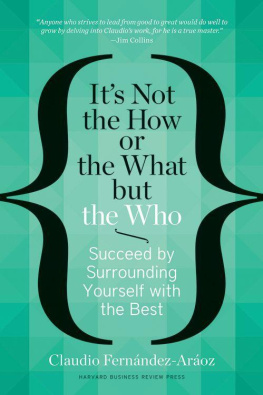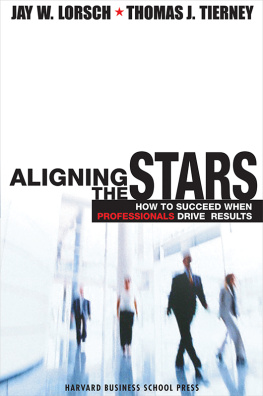
HBR Press Quantity Sales Discounts Harvard Business Review Press titles are available at significant quantity discounts when purchased in bulk for client gifts, sales promotions, and premiums. Special editions, including books with corporate logos, customized covers, and letters from the company or CEO printed in the front matter, as well as excerpts of existing books, can also be created in large quantities for special needs.For details and discount information for both print and ebook formats, contact .
Copyright 2014 Claudio Fernndez-Aroz
All rights reserved
No part of this publication may be reproduced, stored in or introduced into a retrieval system, or transmitted, in any form, or by any means (electronic, mechanical, photocopying, recording, or otherwise), without the prior permission of the publisher. Requests for permission should be directed to , or mailed to Permissions, Harvard Business School Publishing, 60 Harvard Way, Boston, Massachusetts 02163.
First eBook Edition: June 2014
ISBN: 978-1-62527-152-5
To Mara, the love of my life
Contents
Id like to begin with a tale of two CEOs. They have very different backgrounds. They lead very different companies. But they are united by two things: extraordinary leadership success and the relentless focus on talent that helped them achieve it. Both are committed to hiring only the best, to developing their brightest stars, and to uniting them all in exceptional teamsand, as a result, they boost not only their own careers and organizations but also society.
In my twenty-eight years as an executive search consultant, working across all major industries in more than forty countries, Ive discovered that the key to outstanding performance and fulfillmentin both work and lifeis the ability to surround oneself with outstanding people. This isnt always easy, of course. But these two men have learned how, and my aim with this book is to help you do the same. With the right knowledge, training, and practice, everyone can master the art of great who decisions. First, the CEOs stories.
Jeffrey Preston Jorgenson was born in Albuquerque, New Mexico, in 1964. His mother, the daughter of a US Atomic Energy Commission official, was a teenager at the time; shed married young and started work as a bank teller in the city, no doubt full of hopes and dreams. Unfortunately, little Jeffreys childhood started on a sad note: his father left the family not long after he was born. But his mother quickly found love again with a colleague at the bank, Miguel Bezos, a Cuban immigrant who had come to the United States alone at age fifteen, then worked his way through the University of Albuquerque. The two soon married, and Miguel legally adopted Jeffrey, giving the boy his last name.
Little Jeff Bezos showed an early interest in how things worked: He turned his parents garage into a laboratory, rigged electrical contraptions around the house, and experimented with other projects on the twenty-five-thousand-acre Texas ranch to which his grandfather had retired. As a teenager, he excelled at school, but somehow also found the time to launch his first business, an educational summer camp for fourth-, fifth-, and sixth-graders, which he called the Dream Institute. Fascinated by computers, he went on to study electrical engineering and computer science at Princeton University, then ventured to Wall Street, where he became D.E. Shaws youngest vice president at age twenty-six.
Thats when the idea for Amazon came to him. Bezos had been looking at new ventures in which the company might invest when he came across a startling statistic: the World Wide Web was growing by 2,300 percent per month . He drew up a list of twenty potential products he thought might sell well on the internet and quickly settled on books. He quit his job in 1994 and started working out of his own garage with a few software developers.
While most dot-coms launched in the early 1990s went bust, Amazon flourished, with sales jumping from just $500,000 worth of books in 1995 to $61 billion in dozens of product categories by 2012.
Roger Agnelli was born in 1959 in So Paulo, Brazil. His father, Sebastio, had grown up in the interior of the state, alongside ten brothers and sisters, near the coffee plantation where their own father, an migr from Italy, had toiled long hours in the hot sun. Although Sebastio had only one day of formal school (he was expelled on his very first day after a teacher broke her finger trying to stop a fight between him and another student), he diligently studied his arithmetic at home with a tutor and eventually found success in adulthood as the inventor of an amazing wood dryer and a top exporter of industrialized wood.
From an early age, Roger loved to visit his fathers factory, soaking in its technology, efficiency, and cleanliness. He became passionate about mechanical engineering and planes, but ultimately decided to study economics at the prestigious FAAP in So Paulo. After graduation, he joined the investment banking department of the Bradesco Bank, and eleven years later, at age thirty-three, he was appointed general manager (the banks youngest ever) of the capital markets unit.
From that perch, Agnelli led more than five hundred IPOs, supporting the local and international development of Brazilian companies, and became deeply involved in the massive privatization of the countrys steel, telecommunications, mining, and energy sectors. Thats how he came to run Vale. In 2000 Bradesco asked Agnelli to head the administrative council of a privatized mining company in which it had a major share, CVRD (Companhia Vale do Rio Doce, known as Vale). He got to know the people at the company, led a strategy study, and a year later was appointed managing president and CEO. Then, in just one decade, this grandson of a poor immigrant led one of the largest value creations in corporate history.
Agnelli dreamed of the day when Vale would compete with industry giants and, within a decade, he had achieved it. Vale was the largest non-state-owned company in Latin America and one of the twenty largest global corporations. In 2011, the last year of Agnellis tenure, income was $23 billion on revenues of $59 billion, up from income of $1 billion on less than $4 billion revenue in 2001.
Jeff Bezos and Roger Agnelli have both thrived as CEOs, presiding over monstrous value creation during their tenures. But consider the contrast between their two companies:
- Amazon was a start-up; Vale was an old, formerly state-owned company.
- Amazon was in a hot, new high-tech industry; Vale in a traditional, historic onemining.
- Amazon was born in the United States, by that time the most competitive, developed nation on earth; Vale is based in Brazil, perceived at the time to be a volatile, high-risk emerging economy.
- Amazon grew organically and mostly in the United States; Vale grew both organically and through M&A and expanded around the world very rapidly.
- Amazon is an extraordinary B2C company delivering incredible customer service and now also sophisticated consumer electronics for personal use; Vale is a classic B2B, a producer of commodity raw materials for industry.
So how did these two men from such different backgrounds lead such dramatically disparate companies to such similar success?
Of course, both are incredible leadersamazingly bright, hugely ambitious, and strictly disciplined in pursuing their well-crafted strategies. However, in the corporate worldand most other realms of lifeno one triumphs on his or her own. Success is rooted in relationships, in the people around you. Bezos and Agnelli recognize this fact, understand it, embrace it. And, in my view, thats the most important trait they have in common. They know that, in order to succeed, its not the how or the what but the who .
Next page









